#besano
Explore tagged Tumblr posts
Text
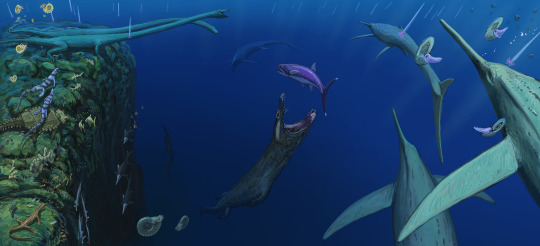
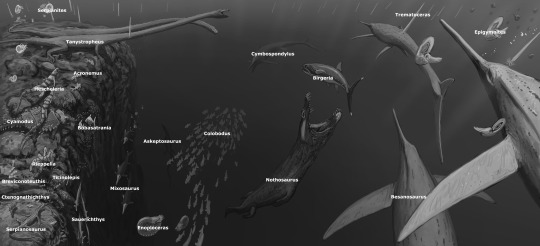
Results from the Besano Formation #paleostream! The middle Triassic has much to offer!
REPOST, SEE REASON BELOW
With formations like these I think it's extremely difficult to find a balance between diversity and a good composition. So although I COULD add more animal to these paintings I also want them to work on an aesthetic level. Paleoart can be more than science outreach.
With formations like this I think it's extremely difficult to find a balance between diversity and a good composition. So although I COULD add more animal to these paintings I also want them to work on an aesthetic level. Paleoart can be more than science outreach
#paleoart#sciart#paleostream#palaeoblr#triassic#italy#switzerland#ichtyosaur#besanosaurus#besano formation#nothosaurus#tanystropheus
232 notes
·
View notes
Text
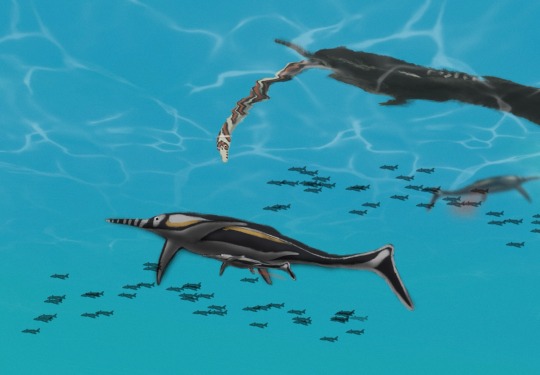
Maysozoic day 28:
Tanystropheus looks at a besanosaurus father swimming with his newborn son while relaxing on an overwater tree
#paleoart#lmao#paleontology#perspective#water#sea#baby animals#baby ichthyosaur#besanosaurus#besano formation#tanystropheus#fish#maysozoic
15 notes
·
View notes
Text
Archovember 2024 Day 27 - Tanystropheus longobardicus
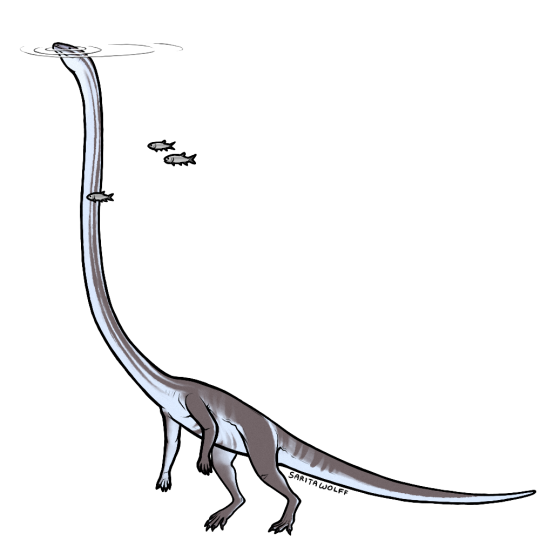
Our last non-archosaur archosauromorph of this Archovember (say that 5 times fast) is Tanystropheus longobardicus. This archosauromorph lived in the Middle Triassic of what is today the border of Italy and Switzerland. It’s most recognizable feature is its long neck, made up of 13 lengthened vertebrae, that stretched out longer than its body and tail combined! What it was doing with this long neck is the subject of debate. The neck was not very flexible, made of long, stiff vertebrae, though it was lightweight and stabilized by tendons. Tanystropheus was likely a fish-eater, with T. longobardicus in particular being equipped with three-cusped teeth suited for holding onto slippery prey, and fish scales and cephalopod hooklets have been found in the stomach region of some specimens. Its body did not seem to have many adaptations for swimming, though its muscular hindlimbs and tail may have allowed for short bursts of active swimming in shallow water. It’s hypothesized that Tanystropheus was a semi-aquatic ambush predator, either using its long neck to reach across the water and snap up fish like a heron, or waiting in the water like a turtle, its body unseen and long neck appearing like an innocent branch.
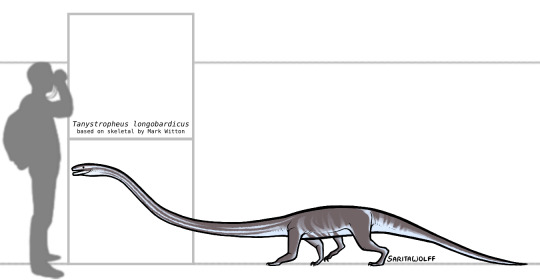
Tanystropheus longobardicus was the smallest of the known species of Tanystropheus. It lived alongside the larger, bulkier T. hydroides, while even larger Tanystropheus specimens have been found in Germany and Poland. Fossils have also been found in Canada and China, meaning this genus may have had a worldwide distribution. But T. longobardicus in particular lived in the Besano Formation. It was set apart from the larger T. hydroides by its small size, narrow triangular head, and tricuspid teeth in the back of its skull. Meanwhile, the larger T. hydroides had a broader skull and long interlocking fangs. The two species likely did not compete, as T. hydroides would have preferred much larger fish than T. longobardicus. But these were not the only tanystropheids in the Bessano Formation. They would have also lived alongside the smaller, shorter-necked, terrestrial tanystropheid Macrocnemus bassanii. On land, Tanystropheus longobardicus would have had to worry about the early rauisuchian Ticinosuchus. In the sea, Tanystropheus would have had to look out for the nothosaur Nothosaurus, large thalattosaurs like Askeptosaurus, large predatory fish like Birgeria, and even large icthyosaurs like Besanosaurus and Cymbospondylus. It may have also come across smaller icthyosaurs like Mixosaurus, Phalarodon, and Wimanius, as well as placodonts like Cyamodus and Paraplacodus, pachypleurosaurs like Serpianosaurus and Odoiporosaurus, and other reptiles like Silvestrosaurus, Helveticosaurus, and Eusaurosphargis. It could have eaten small fish like Aetheodontus, Cephaloxenus, and Luganoia, and even small coelocanths like Ticinepomis.

This art may be used for educational purposes, with credit, but please contact me first for permission before using my art. I would like to know where and how it is being used. If you don’t have something to add that was not already addressed in this caption, please do not repost this art. Thank you!
#Tanystropheus longobardicus#Tanystropheus#tanystropheid#archosauromorphs#reptiles#Archovember#Archovember2024#Dinovember#Dinovember2024#SaritaDrawsPalaeo#Middle Triassic#Italy#Switzerland#Bessano Formation
53 notes
·
View notes
Text
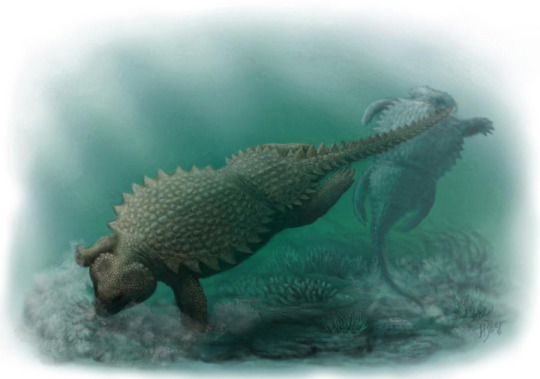
Cyamodus - by NGZver
Cyamodus hildegardis - placodont from the Besano Formation (Middle Triassic) of the Alpine area.
#natural history#palaeontology#paleoart#prehistoric life#prehistoric oceans#placodont#cyamodus#triassic#prehistoric animals
73 notes
·
View notes
Text



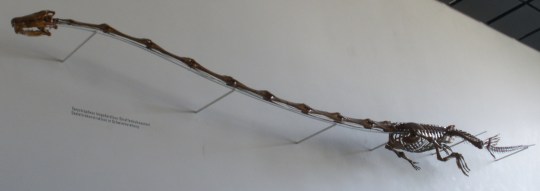
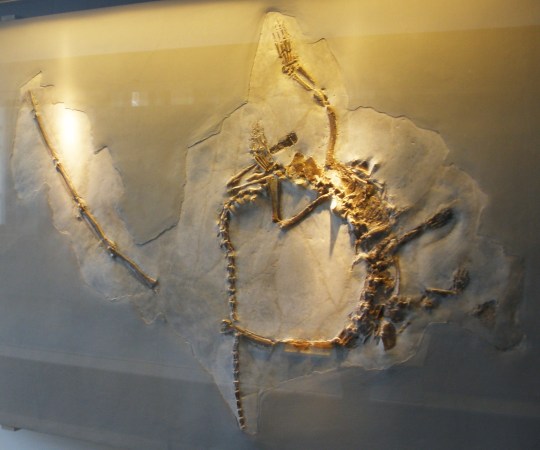
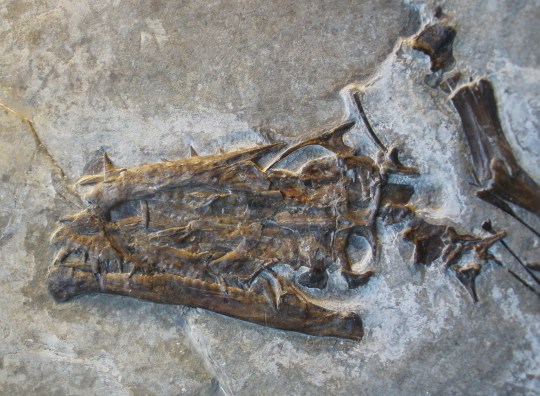
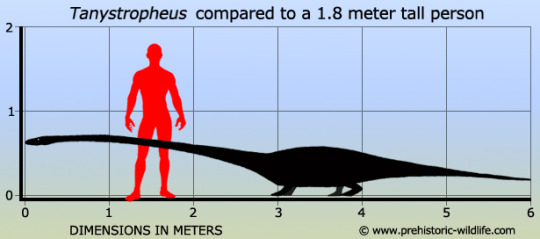
Tanystropheus
(temporal range: 245-235 mio. years ago)
[text from the Wikipedia article, see also link above]
Tanystropheus (Greek: τανυ~ 'long' + στροφευς 'hinged') is an extinct genus of 6-meter-long (20 ft) archosauromorph reptile from the Middle and Late Triassic epochs. It is recognisable by its extremely elongated neck, which measured 3 m (9.8 ft) long—longer than its body and tail combined.[1] The neck was composed of 12–13 extremely elongated vertebrae.[2] With its very long but relatively stiff neck, Tanystropheus has been often proposed and reconstructed as an aquatic or semi-aquatic reptile, an interpretation supported by the fact that the creature is most commonly found in semi-aquatic fossil sites where known terrestrial reptile remains are scarce. Complete skeletons are common in the Besano Formation at Monte San Giorgio in Italy and Switzerland; other fossils have been found throughout Europe, North America, and Asia, dating from the Middle Triassic (Anisian and Ladinian stages) to the early part of the Late Triassic (earliest Carnian stage).
16 notes
·
View notes
Text
Beato Manfredo Settala
www.mirabileydio.it
Beato Manfredo Settala Sacerdote ed eremita 27 gennaio † 27 gennaio 1217 Nobile milanese del XII secolo, era parroco di Cuasso che allora comprendeva le attuali parrocchie di Cuasso al Piano, Cuasso al Monte, Brusimpiano Porto Ceresio e Besano, in diocesi di Milano presso il ramo sud-occidentale del lago di Lugano. Attratto dalla vita eremitica, si ritirò sulle alture del S. Giorgio, la…

View On WordPress
0 notes
Text
Milano: scoperto un primo scorpione triassico italiano

Milano: scoperto un primo scorpione triassico italiano. Una nuova importante scoperta paleontologica tra i fossili conservati al Museo di Storia Naturale di Milano ed estratti dal giacimento UNESCO di Besano-Monte San Giorgio. Un piccolo pezzo di roccia dolomitica, aperto in due, ha rivelato il corpo di uno scorpione. In soli 4,4 centimetri di lunghezza l'animale è conservato integro, con occhi, zampe e coda completa di aculeo. Coordinati dal paleontologo del Museo di Storia Naturale Cristiano Dal Sasso, i ricercatori Marco Viaretti e Gabriele Bindellini, afferenti al Dipartimento di Scienze della Terra "A. Desio" dell'Università di Milano, hanno studiato in dettaglio un prezioso fossile di scorpione, scoprendo che si tratta di una nuova specie, ora battezzata ufficialmente Protobuthus ziliolii sulla rivista scientifica internazionale Paläontologisches Zeitschrift. Gli artropodi terrestri sono fossili molto rari. Questo esemplare è il primo scorpione dell'Era Mesozoica scoperto in Italia e la seconda specie al mondo del genere Protobuthus. "Le mie congratulazioni al team di ricerca per l'importante scoperta, che conferma l'identità dei musei civici milanesi come importanti centri di ricerca scientifica e artistica – ha affermato l'assessore alla Cultura Tommaso Sacchi –. In particolare, il Museo di Storia Naturale, oltre a un team di conservatori competenti e appassionati, ha diversi laboratori tecnici per lo studio e la conservazione delle ricche collezioni museali, che consentono non solo la loro valorizzazione, ma anche un continuo lavoro di analisi e ricerca. Un impegno costante che fa del Museo un organismo vivo e in costante evoluzione, e che la comunità dimostra di apprezzare moltissimo dal momento che continua ad essere uno dei musei più visitati della città". Con l'aiuto della luce UV e del microscopio elettronico a scansione presente nei laboratori del Museo di Storia Naturale di Milano e comandato dal tecnico Michele Zilioli, il team di paleontologi italiani ha accertato che "il fossile è il corpo stesso dello scorpione e non una semplice 'exuvia', cioè non è l'esoscheletro vuoto, che gli artropodi abbandonano più volte crescendo nel corso della loro vita, e che ha dunque più possibilità di fossilizzare rispetto al corpo originale – spiega Viaretti –. È proprio il corpo originale, che ha conservato l'ornamentazione carenata, che ci ha permesso di distinguerlo dagli altri Protobuthus e di stabilire che si trattava di una specie ancora sconosciuta". Il fossile è stato estratto dagli strati superiori del giacimento di Besano, in provincia di Varese, uno tra i più importanti giacimenti fossiliferi al mondo del Triassico Medio, epoca geologica compresa tra 247 e 237 milioni di anni fa. I fossili di questa montagna, noti per la loro varietà e per l'eccezionale stato di conservazione, sono stati portati alla luce e analizzati a partire dal 1850 da paleontologi svizzeri e italiani. "Quei sedimenti dunque confermano di essersi depositati in acque basse, non lontano dalla riva da cui proveniva la carcassa dello scorpione – afferma Bindellini –. I sedimenti sottostanti, invece, si formarono in tempi precedenti, quando quel bacino era molto più profondo. E infatti contengono pesci di mare aperto e rettili tipicamente marini, come gli ittiosauri che hanno reso famoso nel mondo il giacimento di Besano-Monte San Giorgio", conclude Dal Sasso. Il reperto non è stato ancora esposto al pubblico, ma farà certamente parte di un nuovo percorso dedicato ai fossili lombardi, che sarà allestito nei prossimi anni al piano terra del Museo di Storia Naturale di Milano.... #notizie #news #breakingnews #cronaca #politica #eventi #sport #moda Read the full article
0 notes
Photo

Dove tutto ha avuto inizio #italia #vecchitempi #primigiorniinItalia #primacasa #italia #nostalgia #besano #gioia #positivo #casa #home #me (presso Sacro Monte di Varese)
1 note
·
View note
Text
Tanystropheus

By @stolpergeist
Etymology: Long hinge
First Described By: Meyer, 1852
Classification: Biota, Archaea, Proteoarchaeota, Asgardarchaeota, Eukaryota, Neokaryota, Scotokaryota, Opimoda, Podiata, Amorphea, Obazoa, Opisthokonta, Holozoa, Filozoa, Choanozoa, Animalia, Eumetazoa, Parahoxozoa, Bilateria, Nephrozoa, Deuterostomia, Chordata, Olfactores, Vertebrata, Craniata, Gnathostomata, Eugnathostomata, Osteichthyes, Sarcopterygii, Rhipidistia, Tetrapodomorpha, Eotetrapodiformes, Elpistostegalia, Stegocephalia, Tetrapoda, Reptiliomorpha, Amniota, Sauropsida, Eureptilia, Romeriida, Disapsida, Neodiapsida, Sauria, Archosauromorpha, Tanystropheidae
Referred Species: T. longobardicus, T. meridensis
Status: Extinct, sadly
Time and Place: Tanystropheus lived in the middle Triassic, about 245 to 237 million years ago.

Fossils of Tanystropheus have been found in Europe, Israel, and southern China.

Physical Description: Tanystropheus is rare among Triassic weirdos in being reasonably well-known among non-specialists, though rarely by name. The reason it’s so well-known? That truly, ridiculously, insanely long neck. Its neck was so long, in fact, that it made up over half of its body length—and this is not a short animal we’re talking about, with adults reaching up to six metres in length. The neck is made up of 13 elongated vertebrae, and these vertebrae were hollow.

(Image: A skeletal reconstruction of Tanystropheus, showing its extremely long neck and small head. Image by Mark Witton [Source])
You might notice a few other interesting things from this skeletal. Firstly, the body is surprisingly skinny, not enormously round as in many other long-necked animals (see: sauropod dinosaurs). The neck vertebrae have elongated cervical ribs that would have probably hindered motion as well as helped support the neck.

(Image: Diagram of the skull of juvenile Tanystropheus. It is a roughly triangular skull with a large eye and conical, interlocking teeth at the front and triple-cusped teeth in the back. Image from Nosotti, 2007)
Tanystropheus had interlocking, conical teeth in the front of its mouth. Interestingly, juveniles seem to have had triple-cusped teeth in the “cheek” region (though they lacked cheeks), while adults had more needle-like teeth.
Diet: If its conical, interlocking teeth weren’t enough evidence of diet, the fossils of fish scales and squid suckers inside its stomach are. Tanystropheus was piscivorous.
Behavior: The behaviour of Tanystropheus has been a source of some contention. Aside from the brief time it was thought to be a flying animal (crazy, right? The long vertebrae were mistaken for pterosaur wing bones), it’s been assumed to be an aquatic or semi-aquatic animal. However, debate has remained over whether it was a swimming marine predator or the Triassic equivalent of a heron.
Frankly, I think the evidence is pretty one-sided. With a stiffened, poorly-muscled neck, a tail that isn’t flattened from side-to-side, and air-filled vertebrae, Tanystropheus bears little resemblance to marine predators, and likely lived a more heron-like lifestyle.
Ecosystem: Tanystropheus fossils are found in marine or freshwater deposits, and it seems likely that it made its home alongside watercourses or shorelines. As evidenced by stomach contents it clearly lived alongside squid and fish; these rocks also contain ichthyosaurs, bivalve molluscs, and protomammals.
~ by Hayley Orlowski
Sources Under the Cut
Nosotti, S. (2007). " Tanystropheus Longobardicus"(Reptilia, Protorosauria): Re-interpretations of the Anatomy Based on New Specimens from the Middle Triassic of Besano (Lombardy, Northern Italy). Società Italiana di Scienze Naturali e Museo Civico di Storia Naturale.
Witton, M. (2015). The lifestyle of Tanystropheus, part 2: coastal fisher or first-day-on-the-job aquatic predator? Retrieved from http://markwitton-com.blogspot.com/2015/12/the-lifestyle-of-tanystropheus-part-2.html
#tanystropheus#tanystropheid#archosauromorph#triassic#triassic madness#triassic march madness#prehistoric life#paleontology
423 notes
·
View notes
Text
Besanosaurus leptorhyncus

Art by: Dmitry Bogdanov, CC BY-SA 4.0
Name: Besanosaurus leptorhyncus
Name Meaning: Besano lizard
First Described: 1996
Described By: Dal Sasso and Pinna
Classification: Chordata, Tetrapoda, Reptilia, Ichthyopterygia, Ichthyosauria, Shastasauridae
Besanosaurus existed during the Middle Triassic and was discovered in the Sasso Caldo Quarry in Northern Italy. It did not have a typical dorsal fin as seen in the later derived ichthyosaurs. Interestingly, four fossilized embryos were found within a Besanosaurus specimen which infers that ichthyosaurs gave live birth to their offspring, they did not lay eggs in the open sea, and they certainly did not come back on land to lay eggs. All of the outdated paleoart that you may have seen showing an ichthyosaur on land or a plesiosaur on land burying eggs are simply outdated and is inaccurate.
Sources:
http://www.prehistoric-wildlife.com/species/b/besanosaurus.html
https://en.wikipedia.org/wiki/Besanosaurus
#Besanosaurus#paleontology#palaeoblr#Besanosaurus leptorhyncus#palaeontology#prehistoric#Prehistoric Life#ichthyopterygia#Mesozoic#Mesozoic Era#ocean#aquatic#marine#sea#ancient marine reptile#ancient marine reptiles#marine reptile#marine reptiles#geology#biology#Not a dinosaur#paleoart#palaeoart
82 notes
·
View notes
Text
Besano
Da dan okuješ u noć
I onda drugi krug
Sklopi oči na tren jer dovoljno je
Ovo što sad imaš
Vrijednije je od sna
Nemoj da gubiš
Naslonim glavu na trup
Koji se ritmično diže i spušta
Dotaknem obrazom mjesto
Gdje kuca ono što nemam a imam
Što čuvam
Blago, kao ni jedno drugo
Volim te
Reći ćeš
Prešutit ću
Nikada ništa mi neće biti tako sveto
Da li sklopiti oči
I usniti da ruka koja me grli
Nosi prsten
koji je samo veća verzija
Ovog kojeg nosim i ja
Postelja je ista, a samo moja i tvoja
Da ne znam
Je li život san
Ili je san život
Ipak ne
Ostat ću tu u stvarnosti
Voljeti te onako kako mogu
Najbolje i najljepše što znam
Sad
Odmah
Istog trena
Prešutiti ono volim te
Jer ti znaš
Da tišina vrišti
Kako si jedan i jedini
Sad
A ako te kasnije ne bude
Sve će to da ostane
Neprospavana noć
Na grudima koje su sigurno tlo
Čovjeka
koji je u vječitim borbama Hoćinskim
Tvoja sad,
A i ako bude ono ne daj Bože
Uvijek malo tvoja
Ali neka
Ja znam da sad,
Besano,
Volim te🖤
2 notes
·
View notes
Text
Oh, if "He Who Gets Slapped" was popular... And if there was a story based on it it in Time Princess... Besano would be a simple—minded old friend, He would be a mysterious tragic character, whom Consuelo in the end gradually brings back to normal life, and the baron would probably be that creepy villain with whom there is no plot line, but no one regrets it, because he is drawn ugly. But the most important thing is would be cool circus costumes: a typical equestrian costume, a costume with a more obvious circus flavor, a white dress decorated with roses for a benefit, and probably something more simple. Plus facts about Italy and the circus.
0 notes
Text
Triassic Beds of Lake Lugano and Ticino In Switzerland
Lake Lugano Switzerland
Lake Lugano is a glacial lake in southern Switzerland and borders Italy. It is situated between the Alps and the Lepontine Alps in the canton of Ticino. The lake and surrounding area are popular tourist destinations, with many villas situated around the shores. The average water temperature at Lake Lugano is 10 degrees Celsius in the summer and 2 degrees Celsius in the winter. It has a surface area of 48.7 km² and a maximum depth of 288 m. The lake is fed by the River Ticino and has a drainage basin of 9,000 km². The main towns on the shores of the lake are Bellinzona, Lugano, Mendrisio, and Locarno. The lake is popular for its recreational activities such as boating, fishing, swimming, and windsurfing.
Popular Attractions on the Lake
Lake Lugano is a popular tourist destination in Switzerland. The lake is surrounded by mountains, making it a picturesque location. There are many popular attractions on the lake, including the Villa Diodati, the Botanical Garden, and the Villa Silvia. Lugano Mountain is the highest peak in the canton of Ticino and the highest point in Switzerland. The mountain is part of the Pennine Alps and is located in the municipality of Lugano. It has an elevation of 2,997 meters. Lake Lugano is known for its amazing views, and there are many top attractions located around the lake. Some of the top attractions include the Villa d’Este, the Villa Monastero, the Castelgrande, and the Botanical Garden.
Geology of the Area
The lake is 48.7 km2 in size, 63% of which is in Switzerland and 37% in Italy. It has a maximum width of about 3 km at the bay of Lugano. A maximum depth of 288 m is found in the northern basin. The pyramid-shaped, wooded mountain of Monte San Giorgio is located beside Lake Lugano and is regarded as the best fossil record of marine life from the Triassic Period (nearly 245 million years ago). Diverse marine life flourished within this lagoon, including reptiles, fish, bivalves, ammonites, echinoderms, and crustaceans. The area comprises Triassic carbonate formations, mostly within the protected area, which outcrops between both older volcanic and more recent sedimentary formations of the Southern Alpine Series in the buffer zone.
Permian andesites and rhyolites of volcanic origin are exposed on the north face of lake Lugano. Jurassic limestone formations occur on the lower slopes which dip at the mountain foot under the sediments of the Po valley. The Middle Triassic sequence occurs in beds of limestone more than 1,000 m thick. The Triassic sequence includes conglomerate and sandstone (Bellano formation), reef limestone, dolomites and bituminous shales (Besano formation – the main fossil-bearing horizons), marls, limestones and gypsum (Pizzella marls), marine dolomites and dolomitized oolitic limestone (Tremona beds).
Activities on and around the Lake
Lake Lugano is a great destination for a lake vacation. It is surrounded by mountains, making for beautiful scenery. There are many popular Spots located around the lake, making it a great place to enjoy some recreation. Some of the most popular include swimming, boating, fishing, and hiking. A day trip to Lugano is a great way to enjoy the sights and sounds of the city without having to stay there overnight.
Also read- The Great Plains USA: History, Facts, Map And Geology
Morcote village
Morcote is a popular village located on the shores of Lake Lugano. There are many restaurants and shops located in the village. Morcote is also home to Morcote Castle, which is a popular tourist attraction. Apart from this Lugano villages include, Bellinzona, Cossonico, and Sarnico.
Lake Ticino, Switzerland
Lake Ticino is a large lake in the Swiss Alps and it is also the second deepest lake in Switzerland. The lake is popular for boating, swimming, fishing, and hiking. There are many places located around the lake, including the Finsteraarhorn, the Jungfrau Region, and the Seelisberg. It is surrounded by some of the most popular tourist attractions in the country. There are plenty of activities to enjoy on and around the lake, including swimming, hiking, boating, and skiing. The weather and temperature can vary depending on the time of year, so be sure to check the forecast before your visit.
0 notes
Link
Sgominata la Baby Gang brianzola, i carabinieri hanno arrestato a Besana in Brianza otto minorenni e ne hanno denunciati quattro #babygangbrianzola #beanainbrianza #rapineintimidzioni
0 notes
Text
0 notes
Text
Kakav trag sam ostavila na ljude u mom životu, koji sad više nisu tu ali su nekad bili glavni akteri? Da li sam ostavila trag? Da li me se sete uz neku pesmu, uz neko besano dočekivanje zore, uz makar suncokrete? Da li ih zvuk zarđalih žica na klaviru podseti na mene ili kakav razgovor u kom bi tačno čuli moj odgovor? Da li sam ih dodirnula tako makar da zavređujem bar trenutak neke nostalgije koja miriše na mene? Tužna sam pomalo, jer želim to da znam. Želim da znam da nisam prolazna, da ostanem očuvana u duši makar toliko. Ili je to možda čak isuviše bolno? Umem li ja da nekog bolim? Tako daleka, a da sam tako blizu? Zapravo ne znam, a volela bih da posedujem bilo kakvu emociju u tim životima, makar ona bila i setna.
0 notes